Last Exile: The Complete Collection (7 Discs) (DVD)
Introduction
When it comes to fantasy entertainment, there is whole wealth of imagination out there. Turn on your television, and once you've finished sifting through the shopping channels, the home improvement shows, and the abrasive bear-baiting talk shows, you can find anything from futuristic sci-fi to sword and sorcery epics. Rare on our screens however is the alternate history/parallel worlds stories. There is the occasional world of the week show like Sliders, but rarely do you see a whole series being crafted around just one parallel world, although nu-Who has done a remarkable job of creating an alternate universe for its characters. But you see these ideas in literary fiction all the time, although they usually boil down to a rather tiresome, 'what if Hitler won the war?" postulate. But the twist of fate can be so much more creative than that, and genres like Steampunk have arisen, with worlds where the Industrial Revolution never ended, and inventors went on to create steam powered space ships, and clockwork computers. It's not a story form that gets a lot of time on our screens in the West, not least because the few attempts there have been have been lacklustre at best, dire at worst. I'm thinking of The League of Extraordinary Gentlemen, Wild, Wild, West, and Sky Captain and the World of Tomorrow. It's the latter that interests me, as I have a fond nostalgia of the Golden Age of flight, pre jet age with zeppelins and flying boats filling the sky. It was an age that died with the Hindenburg, and I often wonder how the world would have turned out had history taken a different path. I got a brief, vicarious thrill from a computer game called Crimson Skies that took this idea and flew with it, but generally Western media has been silent on the matter.
Fortunately there is always anime, and unlike the three offerings I mentioned before, Japanese animation has a rather impressive track record of developing and delivering compelling stories set in parallel worlds and alternate histories. Steampunk was the genre behind Katsuhiro Otomo's film Steamboy, and Full Metal Alchemist offered an alternate early 20th Century world where the world's main form of technology was based on alchemy rather than electronics. It turns out that my Golden Age of Flight fantasy has also been catered for, with Last Exile, a Gonzo CGI/2D extravaganza with an epic storyline. It's an alternate world where flight works on different principles to our own, there's no need for wings and rotors, instead it's a world where giant ships sail the skies as they do the oceans on our own, and where messages and cargo are transported by swift little vanships piloted by brave couriers. It's a world with a 1920's sensibility to it, with art deco styling, a Marquis of Queensbury attitude to air combat, and aviators who wear goggles and scarves. It's seven discs full of 'Squee' for this reviewer, and I have to wait a bit for the golden sparkles to fade from my eyes before I start watching it.
It's a world at war, with the water poor land of Anatoray locked in conflict with the icebound land of Disith. Both lands are separated by a powerful air current known as the Grand Stream, making travel between the two lands difficult for lesser craft. But massive warships traverse the barrier to attack the other side. It's all done in a civilised way, as befitting two civilised nations. Musketeers volley at each other, followed by artillery barrages, and once the damage is totalled up, the victor is declared. All of this is overseen by the all-powerful Guild, the technological superpower that supplies the technology that both sides need to operate their flying vessels. There are exceptions to that state of affairs. Vanships are small, two-person craft that work without Guild technology, and brave pilots use them for reconnaissance, courier missions and deliveries. Also there is the legendary Silvana, an awesome battleship under the independent command of Alex Row that wreaks havoc on whichever battlefield it graces, fighting for whatever cause its captain deems deserving.
Claus Valca is a young vanship pilot, and Lavie Head is his redoubtable navigator. They were orphaned ten years previously when their fathers attempted to brave the Grand Stream to carry a peace treaty to end the war. They were never heard from again, and the children inherited their fathers' courier business, along with a dream to fly in the Grand Stream. Now teenagers, they make their living flying courier missions, and racing in the vanship tournaments that take place from time to time in their home of Norkia. All that changes when they take on a mission to deliver a letter to a battleship commander in the middle of a warzone. The danger is manageable, as couriers are usually deemed to be neutral, but all of a sudden the Guild are rewriting the rules of combat, and favouring one side over another. Claus winds up improvising during the battle, and the two children influence the outcome. Then during the next race, a courier crashes in the course, shot down by a Guild star-fish. The dying pilot passes his charge over to Claus and Lavie, a young girl named Alvis, and asks them to keep her safe and deliver her to the Silvana. Al is a special child, much in demand by not only the forces of Anatoray and Disith, but by the Guild as well. Claus and Lavie wind up fleeing for their lives when a star-fish attacks their home.
They manage to get Alvis to the Silvana, but they find a ship that's hardly conducive to the well being of a child. They've also become attached to Al, and Claus decides to stay aboard the Silvana to keep her safe. Safety is a pipe dream though, and with everyone after Alvis, the Silvana may as well be a floating bull's-eye. There is rumoured to be a strange vessel plying the Grand Stream, an enigma known as the Exile, and ultimately the source of supreme power that all wish to possess. Alvis is reputed to be the key to that power. Claus and Lavie will find not only the truth behind their tragic pasts, but also their world's future lies aboard Exile.
The story unfolds across 26 episodes presented on 7 discs from ADV.
Picture
The 1.78:1 anamorphic transfer is your typical anime treatment. The signs of an NTSC-PAL conversion are apparent in an overall softness, and the rare moment of judder, but it is among the stronger such transfers, and the average anime fan will have little to complain about. It is remarkably free of compression artefacts, especially given that the final three discs are single layer, and disc five has the full complement of four episodes to it.
Last Exile is one beautiful looking anime, excelling Gonzo's usual high standards. There are two schools of thought when it comes to 3D CGI. There is the Production I.G. approach, which involves giving 3D objects a cel-shaded finish to make them fit in with the 2D animation better, and the 'sod it let's go all out' approach of Gonzo, which specialises in beautiful artwork first, and consistency second. It relies on the viewer enjoying the story so much that he forgets about the visible seams. It certainly works here, with the vanships, the cruisers and the various other bits of technology coming across with CG precision, against a 2D backdrop and with 2D characters. The world takes on a pastel, almost sepia palette that serves to invoke that bygone age, and the designs of the vehicles and technology do have something of the art deco to them. It's very much a collision of futurism and retro styling, somewhat similar to what George Lucas was aiming for with his Star Wars prequels, but accomplished with greater aplomb here. The animation is excellent, vibrant and fluid, and almost to theatrical standards. There are some breathtaking action moments, and a vanship race that channels the best bit of the Phantom Menace. The quieter moments are very effective, while the action sequences are some of the best that Gonzo have ever created.
Sound
You get a choice of DD 2.0 English and Japanese, along with translated subtitles or signs. It's practically a crime that there is no surround track on these discs. With all the dog fighting, racing, capital ship combat and panoply of sound effects, this title is begging for a surround mix. As it is, the two stereo tracks prove sufficient in giving some separation and space to the sound. The dialogue is clear in both languages, and the English dub is one of the good ones, although my preference as always is for the original language track.
Another reason to lament the lack of a surround track is the music. The opening theme puts the fear of Celt into you with an opening brace of bagpipes, but it's merely the herald for a mellow airy piece of electronica, while the end theme is equally ethereal. The incidental music suits the amazing visuals down to a tee. The score borders on the theatrical at times, soaring pieces that reflect the aerial endeavours of the heroes, as well as suitable bombast accompanying the battle sequences. I'm sure that the OST will be in many a collection.
Extras
The extras on these discs are the same as on the individual volume releases. All seven discs are packaged in a brick case, with a central panel with four discs, two to a side and overlapping, the back of the case holds two more, again overlapping, while the front of the case holds just one. Each of the discs gets the usual animated menus and jacket pictures. Incidentally, the artwork is hideous, with most of the front cover taken up with the bland side of a vanship, and a couple of heads peeking over at the top of the case.
Disc 1
Here you get the clean opening, the original Japanese opening, a 2-minute promotional trailer, character profiles for Claus Valca, Lavie Head and Al (Alvis) E. Hamilton, an Art Gallery with 25 images, and trailers for Mahoromatic, Zaion, Kino's Journey, Generator Gawl, and Final Fantasy Unlimited.
Disc 2
This time you get the clean closing, original Japanese closing, 2½ minutes of commercials, character profiles for Alex Row, Tatiana Wisla and Alister Agrew, an art gallery with 25 images, and previews for Kino's Journey, Evangelion, Get Backers, and Gad Guard.
Disc 3
Character profiles for Sophia Forrester, Mullin Shetland and Dio Eraclea, another Art Gallery with 25 images, and previews for Get Backers, Sakura Diaries, Gravion, Gad Guard, and Evangelion.
Disc 4
You get 17 pages of stills from the Tokyo Exhibition of Last Exile production material, an Art Gallery containing 14 images, 2 pages of text about Vanships, and previews for Aquarian Age, Gad Guard, Gravion, Get Backers, and Chrono Crusade.
Disc 5
This disc has the second textless opening, 12 images in an Artwork Gallery, 2 pages of text about the Silvana, and previews for Divergence Eve and D.N.Angel
Disc 6
You get the second textless opening again, 3 pages of text on Anatoray and Disith Battleships, and Previews for Peacemaker, Gravion, Gad Guard, and Chrono Crusade.
Disc 7
Once more with the second textless opening, a page of text on Guild ships, and to top it off, previews for Gad Guard, Peacemaker, Chrono Crusade and FMP: Fumoffu.
Conclusion
I sort of totally love Last Exile, and I kind of whole-heartedly recommend it. If that seems like a schizophrenic sentence, it's because it is. I'm in two minds about Last Exile, as what it does well, it does so brilliantly that it blows me away, then it comes up with a couple of clangers that would sink lesser series, but I feel like giving it a pass anyway, as it's just so confoundedly entertaining. Gonzo are renowned for their eye-candy, shows that sell more on the strength of their surface glamour than any real depth. But on occasion they do try and marry the two, and produce a show that is as profound as it is pretty. Samurai 7 was one such show, and Last Exile turns out to be another. This is a series where all the stops were pulled out to create a developed and believable alternate world, a set of rounded and interesting characters, and a story that not only has genuine depth to it, but demands your emotional investment as well.
It is an epic tale of three superpowers vying for supremacy over a resource poor world, and like all such socio-political drama, it's ignored in order to tell the story of three young individuals who get caught up in the adventure when all sides race for the ultimate power that is hidden in the mythical Exile. Claus and Lavie are idealistic and young. They've been through shared adversity, and have obviously managed to survive and prosper despite the war, but for them the sky is a peaceful domain. As vanship pilots, their vocation is inherently pacific, they deliver, they carry messages, and they leave the fighting for the big boys. It's a fun profession, built around the romance of the air and their dream is to traverse the Grand Stream that claimed their fathers. It's a false hope anyway; anything can be wielded as a weapon of war, as they find out when Claus gets involved in a battle between Disith and Anatoray. His flying in that battle gets noticed by many on both sides, and changes the face of war forever in a development that mirrors the history of flight in our own world. The first cracks appear in their friendship at this point, as Claus starts rethinking his role in the war, especially when he's so determined to protect their charge Alvis even aboard the warship Silvana. Lavie is a pacifist to the core, and she refuses to use a vanship as a weapon. When it becomes clear that Claus will fight, she refuses to be his navigator, yet she is committed to protecting Al as well.
There are other characters and stories to follow as well, early on we meet Mullin Shetland, a musketeer for Anatoray who has had a whole lot of luck defying the odds of his profession, and finally feels his luck is running out when his ship's commander is censured for cowardice. He leaves the service and winds up on the Silvana as a mechanic, developing a friendship with the new arrivals. The Silvana is a mercenary ship with an assortment of colourful characters, among them the rough and ready mechanics that adopt Mullin as a mascot of sorts. Tatiana Wisla is a by the books, military vanship pilot who serves along with her lifelong friend Alister Agrew. She uses the mercenary money to support her family, and sees the arrival of the green Claus and Lavie as a personal affront. The Captain of the Silvana, Alex Row is a man with a dark past. He too braved the Grand Stream, and he was the sole survivor of his mission, thwarted he believes by the Guild. He blames the leader of the Guild, Maestro Delphine and has sworn revenge. Although he is a genius tactician and infamous on the battlefield, he can be blinded by his thirst for vengeance. It's a good thing he has a capable first officer in Sophia Forrester, a woman who obviously idolises her Captain but is strong and capable in her own right. She also has a past that she is hiding from. Dio Eraclea and his personal servant Luciola soon complete the Silvana contingent. Dio is a young Guild pilot who clashes early on in battle with Claus, then loses to him in a race. Dio is spoilt, ruthless and careless of human life. But he's enchanted when Claus outflies him in something as decrepit as a vanship, and he dubs him 'Immelman' after seeing his signature manoeuvre. He finds that he wants to know Claus better, and regardless of the obvious mistrust and hatred that comes his way, he effectively defects to the Silvana, and eventually becomes part of the crew. But his superiors in the Guild have plans for him.
The show plays like any other episodic anime with an overreaching story. Each episode has a story to tell, but also adds to the larger picture, with the earlier episodes more prone to diversions for the sake of character building, as well as exploring different aspects of the world, while the later episodes focus more and more on the overall story. It's all brilliantly crafted, compelling stuff that is hard to pull away from. It doesn't hurt that the animation is so good, with some truly breathtaking action sequences, fluid character animation, and a world design that has had a whole lot of thought put into it.
So why the schizophrenia? Last Exile has a lot going for it, a whole lot of potential, but in the end it wastes a lot of it. Some of the characters could have used a little more development, some should have just been used more, and not all of the character arcs had fulfilling resolutions. Alex Row for one was never really more than a moody, brooding cipher, and his interactions with the children were too few. It's obvious with hindsight that he was just there for the appropriate plot points, and he never really grew beyond the confines of his stereotype. Other characters that may have made more of an impact, certainly were developed more, wound up wasted in the end, given exits that didn't do justice to their character arcs. Of course that is the fickle way of stories, and not everyone can be the hero. In the real world the stray bullet can and does strike with impunity, and if Last Exile reflects that, that shouldn't necessarily be a bad thing. In the end, as long as the central characters' arcs are resolved well, then that ought to be enough.
Except that it isn't. What really lets Last Exile down is the curse of Gonzo, the stock villain. In a complex world with complex characters, a resource war scenario that paints both sides with various shades of grey, we get an evil moustache-twirling villain of the old school. Only if Maestro Delphine has a moustache, she hides it well, and has anyone who knows about it painfully executed. With all the rounded and layered characters in the show, she's the sore thumb, the villain who is evil for the sake of being evil, who pulls wings off butterflies and torments lesser beings for kicks. Actually, you know if a female in anime is evil if she licks things. Delphine licks things, and then laughs, evilly. There's no motive to her actions, she sees everyone and everything as her own personal plaything, and she delights in causing suffering. It's a simplification of character that lets the story down, and is the most disappointing thing about the show.
The other problem with Last Exile is that for a show with a complex storyline such as this, there are plenty of twists and turns to hold the attention. It's fun exploring this world along with the protagonists, and there is a great deal of entertainment in discovering the little secrets to it. Except that Last Exile saves its biggest twist right for the end, a twist that sheds light on the story, explains much, and tantalises even more. But it's right at the end, practically over the end credits, and minus any commentary from any of the characters. It's a couple of visuals that you are meant to figure out for yourself, and if you blink, you'll miss it. It's the sort of twist that needed a little examination to draw out the implications, but the way that Last Exile presents it; it's really just wasted.
That's a nitpick really, as my gripe is with Delphine, and when I balance it against the sheer beauty of this anime, the world-building and the appealing characters, it begins not to matter so much. Then I recall the excellent animation, the thrilling flight sequences and sheer entertainment value and I've practically forgotten all about it. Last Exile is a fun, entertaining and exciting aerial adventure story, and it's visually and aurally stunning. It has a flaw or two that keep it from classic status, but it is still money well spent. Chocks Away!




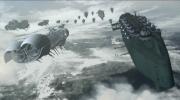







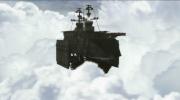
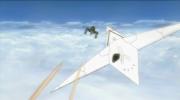


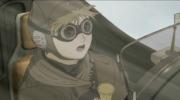



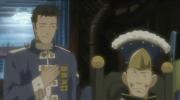
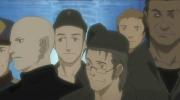



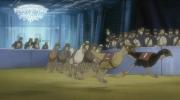



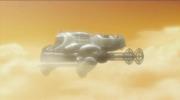












































Your Opinions and Comments
Be the first to post a comment!